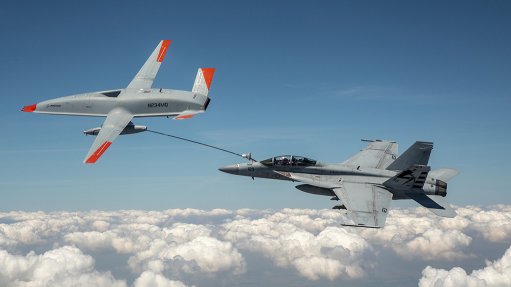
The MQ-25 (left) refuels the Super Hornet.
Photo by: Boeing
US aerospace and defence industry giant Boeing and the US Navy (USN) have jointly made history with the first ever air-to-air refuelling (AAR) by an uncrewed aerial vehicle (UAV) of another aircraft. The test flight during which this was achieved took place on June 4, but the news was only released on Monday (June 7).
The flight involved a Boeing MQ-25 Stingray UAV and a Boeing F/A-18 Super Hornet crewed fighter. The MQ-25 was a Boeing test aircraft, designated T1, while the F/A-18 was a USN aircraft, flown by a test pilot.
“This history-making event is a credit to our joint Boeing and Navy team that is all-in on delivering MQ-25’s critical aerial refuelling capability to the fleet as soon as possible,” highlighted Boeing Defence, Space and Security president and CEO Leanne Caret. “Their work is the driving force behind the safe and secure integration of unmanned systems in the immediate future of defence operations.”
“This team of professionals was integral in the successful flight,” stressed USN Programme Executive Office for Unmanned Aviation and Strike Weapons head Rear-Admiral Brian Corey. “Over the next few years, we will work side-by-side with Boeing to deliver this capability that will greatly enhance the future carrier air wing.”
The successful AAR test flight followed 25 previous flights by the T1 aircraft, during which the aerodynamics of the UAV and of its attached aerial refuelling store (ARS) were both tested across the flight envelope. (The ARS was supplied by the USN.) In parallel, digital simulations of the AAR mission were run using computer models of the MQ-25.
On the actual AAR test flight, which was conducted at operationally-relevant altitudes and speeds, the F/A-18 pilot flew in very close formation with the UAV, coming to within 20 feet (just over 6 m) of it (measured from the MQ-25 to the Super Hornet’s refuelling probe). This was to ensure that flight performance and stability were within the desired parameters, before the AAR was actually undertaken. Following the success of these manoeuvres, the UAV extended the ARS’ refuelling hose and drogue and the Super Hornet pilot inserted (or ‘plugged’) the fighter’s probe into it and then received the planned amount of fuel.
The MQ-25 T1 aircraft will now continue its flight test programme before being taken to Norfolk in the state of Virginia for aircraft carrier deck handling trials with the USN later this year. The T1 will be followed by seven MQ-25 test aircraft being manufactured by Boeing for the USN under a 2018 contract.
Currently, the USN is having to use F/A-18 fighters, fitted with ARS, to refuel other fighters. In service, the MQ-25 would relieve the Super Hornets of this duty, allowing them to be employed in their primary combat role.